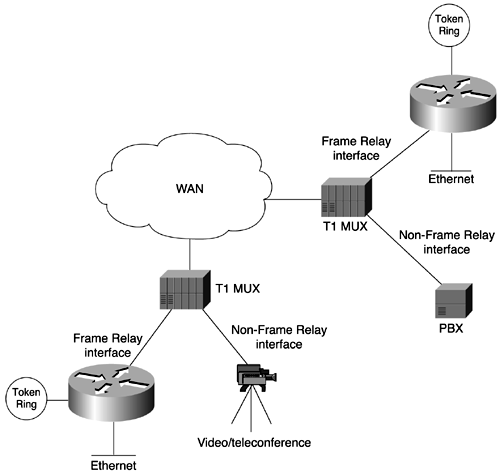Frame Relay Network Implementation
A common private Frame Relay network implementation is to equip a T1 multiplexer with both Frame Relay and nonFrame Relay interfaces. Frame Relay traffic is forwarded out the Frame Relay interface and onto the data network. NonFrame Relay traffic is forwarded to the appropriate application or service, such as a private branch exchange (PBX) for telephone service or to a video-teleconferencing application.
A typical Frame Relay network consists of a number of DTE devices, such as routers, connected to remote ports on multiplexer equipment by traditional point-to-point services such as T1, fractional T1, or 56-kbps circuits. Figure B-3 shows an example of a simple Frame Relay network.
Figure B-3. A Simple Frame Relay Network Connects Various Devices to Different Services over a WAN

Service providers who intend to offer transmission services to customers provision the majority of Frame Relay networks deployed today. This is often referred to as a public Frame Relay service. Frame Relay is implemented in both public carrierprovided networks and in private enterprise networks. The following section examines the two methodologies for deploying Frame Relay.
Public CarrierProvided Networks
In public carrierprovided Frame Relay networks, the Frame Relay switching equipment is located in the central offices of a telecommunications carrier. Subscribers are charged based on their network use but are relieved from administering and maintaining the Frame Relay network equipment and service.
Generally, the telecommunications provider also owns the DCE equipment. DCE equipment either is customer-owned or perhaps is owned by the telecommunications provider as a service to the customer.
The majority of today's Frame Relay networks are public carrierprovided networks.
Private Enterprise Networks
More frequently, organizations worldwide are deploying private Frame Relay networks. In private Frame Relay networks, the administration and maintenance of the network are the responsibilities of the enterprise (a private company). The customer owns all the equipment, including the switching equipment.
| |
| Top |
EAN: 2147483647
Pages: 127